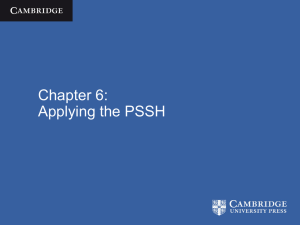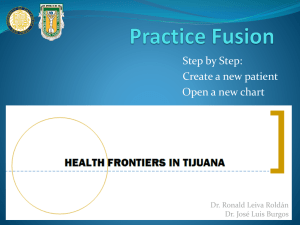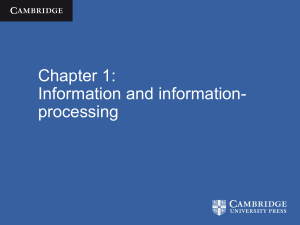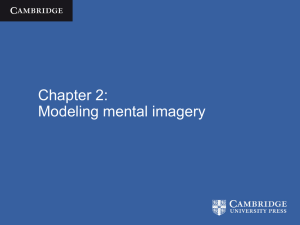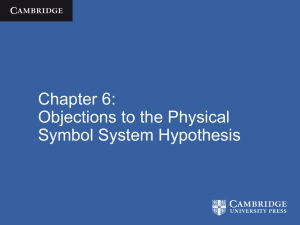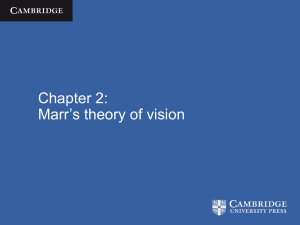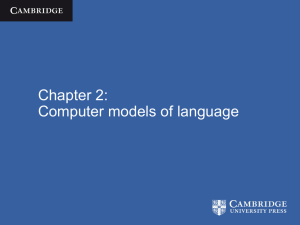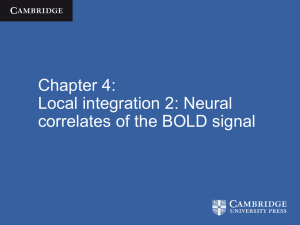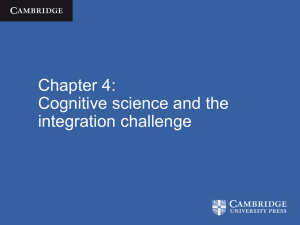Behaviorism and the beginning of
advertisement
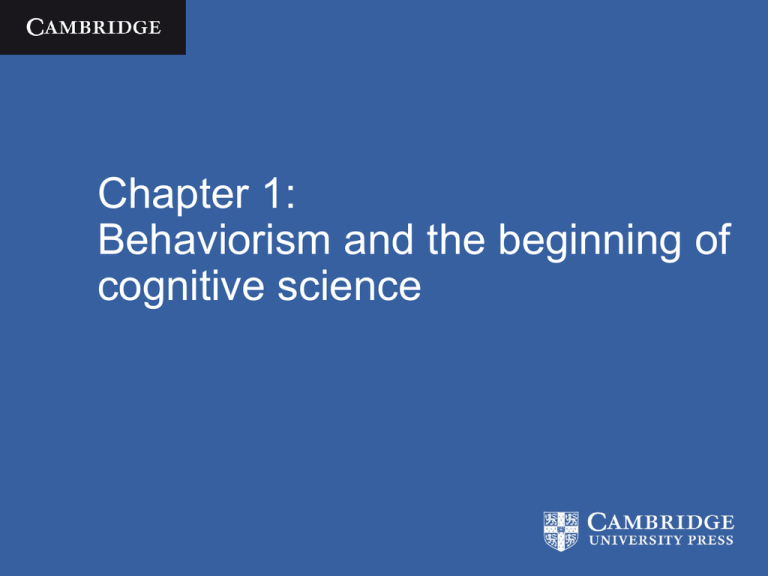
Chapter 1: Behaviorism and the beginning of cognitive science Steps towards cognitive science • The cognitive turn in psychology (away from behaviorism) • Developments in the theory of computation and theory of information • Development of information-processing models of cognitive capacities and abilities Cognitive Science José Luis Bermúdez / Cambridge University Press 2010 Basic principle of behaviorism Rejection of mentalism: (1) appeal to thoughts and desires to explain behavior (2) use of introspection to study conscious mental experience (3) dependence upon verbal reports Cognitive Science José Luis Bermúdez / Cambridge University Press 2010 Mentalism “Psychology is the Science of Mental Life, both of its phenomena and their conditions. The phenomena are such things as we call feelings, desires, cognitions, reasonings, and the like.” William James, Principles of Psychology (1890: 1) Cognitive Science José Luis Bermúdez / Cambridge University Press 2010 Method? • According to James, psychology’s job will be complete when it has “ascertained the empirical correlation of the various sorts of thought or feeling with definite conditions of the brain” • Depends upon being able to identify and classify “the various thoughts of thought or feeling” • Dependence on introspection and verbal reports Cognitive Science José Luis Bermúdez / Cambridge University Press 2010 Behaviorism “The conscious aspect of behavior is undoubtedly most interesting. But we are unable to deal directly with this by the methods of observation and experiment.” “The ideal of most scientific men is to explain behavior in terms of matter and energy, so that the introduction of psychic implications is considered superfluous” H. S. Jennings (Behavior of the Lower Organisms, 1906: v and 329) Cognitive Science José Luis Bermúdez / Cambridge University Press 2010 Two behaviorist projects Philosophical behaviorism • adopted by logical positivists such as Hempel and Carnap (the Vienna circle in the 1920’s and 1930’s) Psychological behaviorism • adopted by psychologists such as Watson (18781958), Skinner (1904-1990), and Pavlov (1849-1936) Cognitive Science José Luis Bermúdez / Cambridge University Press 2010 Similarities • Both philosophical and psychological behaviorism think that we can give a full account of human (and non-human) behavior in non-psychological terms • Both are driven by very similar methodological concerns – problems of verifying claims about “inner” psychological states Cognitive Science José Luis Bermúdez / Cambridge University Press 2010 Differences • Philosophical behaviorism focused on language • Verification principle = verifiability as a criterion for meaningful use of language • Psychological behaviorism focused on explanation of behavior • Explanatory tools that make reference only to behavior • E.g. conditioning theory Cognitive Science José Luis Bermúdez / Cambridge University Press 2010 Classical/Pavlovian conditioning • Depends upon an association between stimulus and response • Certain stimulus-response pairings are inborn and reflexive • Basic reflex responses are unconditionally elicited by certain types of stimuli [e.g. salivation on presentation of food] • These basic responses can be elicited by other stimuli through conditioning Cognitive Science José Luis Bermúdez / Cambridge University Press 2010 The mechanics Unconditional stimulus (US) – e.g. food Conditional stimulus (CS) – e.g. sound of a bell Unconditioned response (UR) – e.g. salivation • Presenting the CS immediately before the US develops an association between the CS and the UR • This conditional reflex is reinforced as the conditioning process continues • It is extinguished once the US is no longer presented (after a certain period of time Cognitive Science José Luis Bermúdez / Cambridge University Press 2010 Interesting fact Pavlovian conditioning works even when the stimulus is noxious Pavlov conditioned dogs to salivate in response to a pinprick These dogs developed a normal salivatory response and showed no aversion to the pin-prick (unlike unconditioned dogs) Cognitive Science José Luis Bermúdez / Cambridge University Press 2010 Instrumental/operant conditioning Pavlovian/classical conditioning works via the US being presented immediately after the CS In instrumental/operant conditioning there is no CS Instead, the US is conditional upon performing a designated response – e.g. pressing a lever Cognitive Science José Luis Bermúdez / Cambridge University Press 2010 Skinner box Cognitive Science José Luis Bermúdez / Cambridge University Press 2010 Interesting fact Omission schedules show that Pavlovian conditioned responses can persist despite their consequences • Suppose a pigeon is conditioned to a flashing light as a CS signaling food delivery • The pigeon will peck the light even if pecking the light brings about the non-delivery of food Cognitive Science José Luis Bermúdez / Cambridge University Press 2010 Behaviorist goal (1) A complete explanation of all behavior in terms of conditioned responses - e.g. • Language as a complex set of conditioned responses – words produced in response to particular objects or situations • Analyzing a sentence as a chain of elements, each serving as a conditional stimulus for the succeeding element Cognitive Science José Luis Bermúdez / Cambridge University Press 2010 Behaviorist goal (2) Operationalization of psychological phenomena Attention is not a mental act of focusing on part of the perceptual field, for example Attention is simply the fact that an organism responds to a single stimulus when there are several stimuli present to which it would otherwise respond Cognitive Science José Luis Bermúdez / Cambridge University Press 2010 Problems for behaviorism • Discovery that learning can take place without reinforcement and that it can involve pick up of information (latent learning experiments) • Discovery that this information need not be information about bodily responses (place learning experiments) • Objections to behaviorist accounts of language (Chomsky’s review of Skinner’s book Verbal Behavior) Cognitive Science José Luis Bermúdez / Cambridge University Press 2010 Latent learning Cognitive Science José Luis Bermúdez / Cambridge University Press 2010 Place learning • Issue is whether movement is made possible by • Chained sequences of conditioned reflexes • Knowledge of spatial relations • Tolman, Ritchie, and Kalish shows that the chained response theory is not always correct sunburst maze experiments Cognitive Science José Luis Bermúdez / Cambridge University Press 2010 Sunburst maze experiments Cognitive Science José Luis Bermúdez / Cambridge University Press 2010 The majority of the rats ended up choosing Path 6 in the sunburst maze. Path 6 ended up just in front of where the entrance to the food box had been - as marked by the light Cognitive Science José Luis Bermúdez / Cambridge University Press 2010 The big picture 1 Latent learning idea of information pick-up and storage Place learning idea of information specifically about the environment (rather than the organism’s own movements) Language idea of hierarchical, rather than serial, organization [special case of Lashley’s analysis of behavior] Cognitive Science José Luis Bermúdez / Cambridge University Press 2010 The big picture 2 Cognitive science grew out of these basic ideas • organisms pick up and process information about the environment [distal, rather than proximal] • this information is organized hierarchically Putting these ideas together was made much easier by two mathematical theories • the theory of information • the theory of computation Cognitive Science José Luis Bermúdez / Cambridge University Press 2010 Overview MONDAY Use Miller’s ‘The magical number 7’ to illustrate how the theory of information can be used in cognitive science MONDAY attention Look at Broadbent’s information-processing model of WEDNESDAY Chomsky’s critique of behaviorist approaches to linguistics FRIDAY Turing and the theory of information Cognitive Science José Luis Bermúdez / Cambridge University Press 2010
